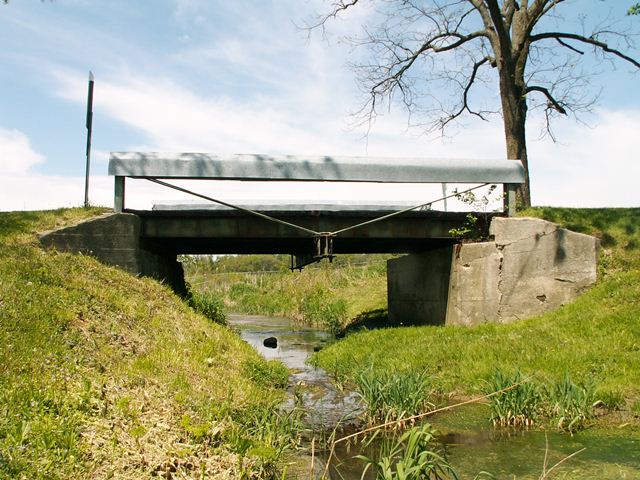We Recommend:
Bach Steel - Experts at historic truss bridge restoration.
Utz Road Bridge
TR-419 Bridge

Primary Photographer(s): Nathan Holth
Bridge Documented: May 7, 2006
Rural: Preble County, Ohio: United States
1887 By Builder/Contractor: Unknown and Engineer/Design: Evrett S. Sherman of Galena, Ohio
Not Available or Not Applicable
18.0 Feet (5.5 Meters)
21.0 Feet (6.4 Meters)
17 Feet (5.18 Meters)
1 Main Span(s)
6834078

View Information About HSR Ratings
Bridge Documentation
Some sources listed this bridge with an 1887 construction date, although it is not known for sure if this is accurate. This small and altered bridge may not be a very visually appealing bridge, but it is rare as the only known example of an unusual patented bridge design. As shown in the patent, the full name of the person who held the patent was Evrett S. Sherman, and he lived in Galena, Ohio at the time. His bridge design as patented functions as an inverted Kingpost truss. Intended only for short spans, it uses diagonals that connect between end posts and a floor beam at the center of the short span. This would allow for deck stringers to be more shallow than if the bridge was built as a steel stringer bridge. As such it was a way to reduce materials costs.
The Utz Road Bridge appears to have been built as one of these patented bridges. As it is the only known surviving example, it is a highly significant bridge. That being said, the bridge is highly altered from its original construction. The deck stringers, although old, are not original. They bear "Jones and Laughlin" brand. Jones and Laughlins dropped the "s" in "Laughlins" in 1905, so these beams date to after 1905. Furthermore, they do most of the load-bearing these days, so that the bridge really functions as a steel stringer, and the inverted Kingpost portion does little to support the bridge anymore.
View Archived National Bridge Inventory Report - Has Additional Details and Evaluation
View The Original Patent For This Historic Bridge Design
Above: Advertisement for this bridge type. Courtesy, John Bland, Galena, Ohio.
Above: Advertisement for this bridge type. Courtesy, John Bland, Galena, Ohio.
Information and Findings From Ohio's Historic Bridge InventorySetting/Context The bridge carries a 2 lane road over a stream in a rural area of active farms. Physical Description The 1-span, 21'-long bridge, although functioning as a steel stringer, incorporates remnants of a combination timber and iron truss bridge that matches the specifications of an 1877 patent by Evrett S. Sherman of Galena, Ohio. The 2-panel, inverted king post trusses have timber upper chords with a housing of galvanized sheet metal. The upper chords rest on rolled I-section end posts, which are not original, and were probably timber in the first iteration of the bridge. Cast-iron blocks at the ends of the upper chord beams provide bolted connections for paired, threaded diagonal iron rods that pass through the upper chords. At the other end of the diagonals are loop-welded eyes that support a pair of stirrups for the bridge's only floorbeam. The floorbeam is a rolled I-beam that is not original, and was probably timber. One of the truss lines has a timber vertical post at midspan, but the vertical has been lost from the other truss. The steel stringers and wood plank deck are not original. The bridge is supported on stone abutments. Integrity The truss lines retain the form of the Sherman patented truss, but original materials appear to be the hardware, diagonals, and perhaps the timber upper chords and remaining vertical. Summary of Significance The bridge's technological significance is a very rare survival of a composite (wood and iron), short-span pony truss that matches the patent specifications of Evrett S. Sherman's patent of 1877 (No. 191,552). This patent was for short-span bridges, and was typical of the innovative period of truss development and the search for economical, easy-to-construct bridges that came in an almost infinite variety reflecting the inventors' choice of materials, web patterns, and details for connecting the members. Sherman, who haled from Galena, Ohio, claimed in his patent that "the construction and parts of this bridge are extremely simple, cheap, and as such require no skilled mechanics in bridge-building to erect." Although once common in the late 19th century, these type of short-span, composite pony truss bridges have all but virtually disappeared from the American landscape. The bridge has lost original fabric and is no longer functioning as intended, but retains sufficient original materials, including the iron hardware, to convey its technological significance as a very rare survival. Justification The bridge is rare example of a composite design and has high significance. It is also a rare design. Bridge Considered Historic By Survey: Yes |
![]()
Photo Galleries and Videos: Utz Road Bridge
Bridge Photo-Documentation
Original / Full Size PhotosA collection of overview and detail photos. This gallery offers photos in the highest available resolution and file size in a touch-friendly popup viewer.
Alternatively, Browse Without Using Viewer
![]()
Bridge Photo-Documentation
Mobile Optimized PhotosA collection of overview and detail photos. This gallery features data-friendly, fast-loading photos in a touch-friendly popup viewer.
Alternatively, Browse Without Using Viewer
![]()
Maps and Links: Utz Road Bridge
Coordinates (Latitude, Longitude):
Search For Additional Bridge Listings:
Bridgehunter.com: View listed bridges within 0.5 miles (0.8 kilometers) of this bridge.
Bridgehunter.com: View listed bridges within 10 miles (16 kilometers) of this bridge.
Additional Maps:
Google Streetview (If Available)
GeoHack (Additional Links and Coordinates)
Apple Maps (Via DuckDuckGo Search)
Apple Maps (Apple devices only)
Android: Open Location In Your Map or GPS App
Flickr Gallery (Find Nearby Photos)
Wikimedia Commons (Find Nearby Photos)
Directions Via Sygic For Android
Directions Via Sygic For iOS and Android Dolphin Browser
USGS National Map (United States Only)
Historical USGS Topo Maps (United States Only)
Historic Aerials (United States Only)
CalTopo Maps (United States Only)




